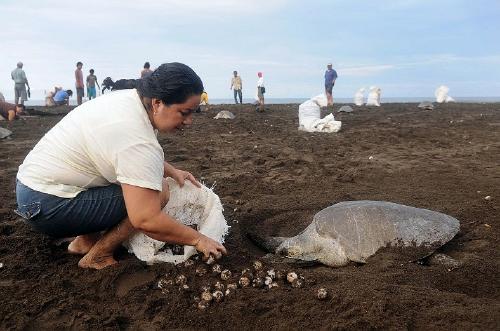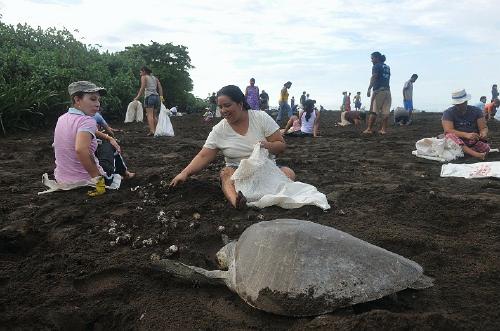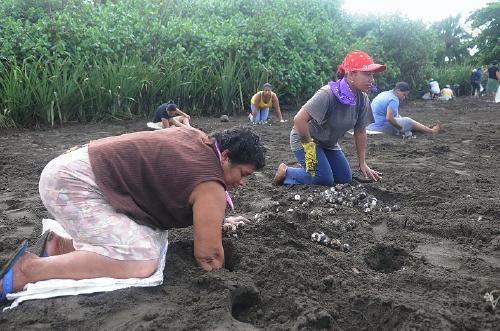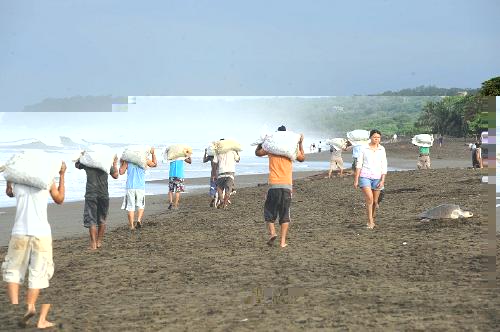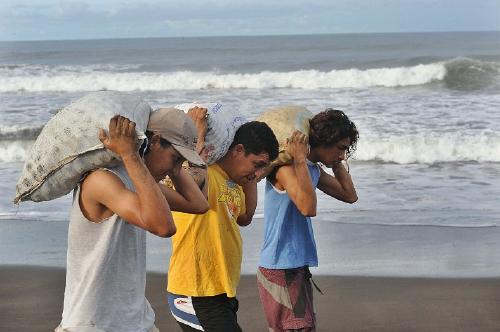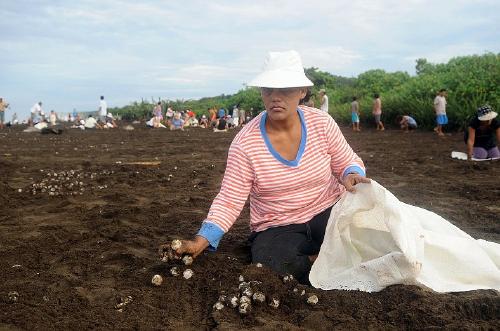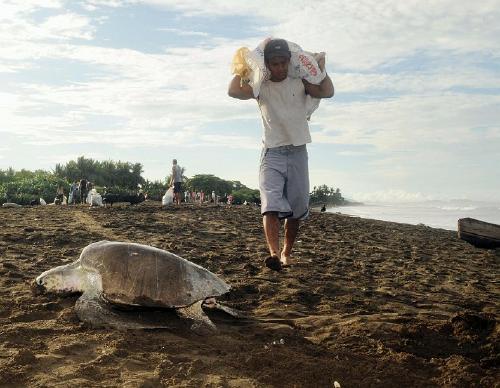Claim: Photographs show poachers collecting sea turtle eggs in Costa Rica.
Example: [Collected via e-mail, March 2010]
Aha, maybe we have just discovered why the sea turtle is going extinct & it is not global warming. !!!!!!!....
Sending you an e-mail of the turtle poachers on the beaches of Costa Rica.
See the 2nd picture too, where the female cannot cover up her own eggs, before the intruder steals away what Nature has given her to protect her young. These people have unfortunately, taught their children nothing for the future generation to cherish. Look at these children and they do not know anything about conservation of Marine Life Protection and look at the disastrous road their parents are taking too...
What have they they all gained for the future of Costa Rica's Marine Life protection? World Wide shame in COSTA RICA.
Please distribute widely. The Turtle eggs are stolen to be sold. The PLANET IS THANKFUL.
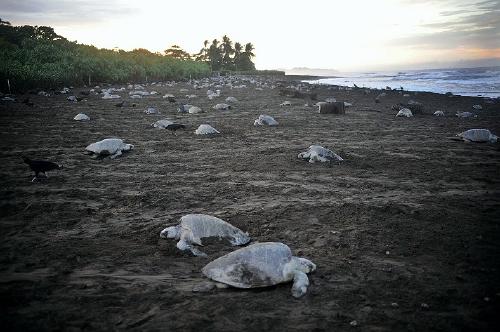
Origins: These photographs do show the collection of
For 10 months of the year, usually around the third quarter of the moon, olive ridleys swim by the hundreds of thousands to a single mile of beach at Ostional in an ancient reproductive rite little understood by scientists. They scuttle onto the sand, dig a hole with their flippers, and drop in an average of In the early 1980s, scientists learned that because of limited space on the beach, females arriving later destroy the first laid eggs. The researchers wondered: why not let poachers have the doomed eggs? Under a law written especially for Ostional, the government allows an egg harvesting cooperative to collect all they can during the first 36 hours of every arribada. Coop members then truck the eggs around the country, selling them to bars and restaurants. In return, the community must protect the olive ridley. Coop members clean debris from the nesting areas and patrol the beach day and night for poachers. Forty days later, when the hatchlings emerge, children from the Ostional Primary school run to the beach. "We protect the tortugitas when they crawl to the ocean. If we don't, the vultures will get them and bite their heads off," says a local 8-year-old boy, breathlessly.
In the coastal town of Ostional, located on Costa Rica's Guanacaste Peninsula, a 13-year-old project has helped stabilize the population of the olive ridley sea turtle.
A Sea Turtle Conservancy (STC) representative noted that the activity pictured here is controversial but legal (Ostional is the only part of Costa Rica where sea turtle egg gathering is allowed), and that investigation to determine its overall effect on the olive ridley population is ongoing:
This is a very controversial subject among sea turtle scientists, conservationists and community members in Costa Rica. Among other issues, the legal sale of any turtle eggs in the country opens the door for clandestine egg harvesting from other parts of the country. The photos being circulated have served as a catalyst for the Costa Rican National Sea Turtle Conservation Network (of which STC is an integral part) to initiate an investigation of the scientific justification for this egg harvest. Specifically, the group is investigating the validity of claims that the harvest increases (or at least doesn't reduce) overall hatching productivity on this beach. The claim put forth is that during an arribada, many of the first nests to be laid are dug up and destroyed by females attempting to nest in the same spot days later. Not only are the earliest nests often destroyed, the rotting eggs become putrid and attract lots of bugs and predators, thus threatening the last nests deposited. A committee of the CRNSTCN was formed (on which STC's scientific director, Dr. Emma Harrison serves) to investigate the issues surrounding this legal harvest further. In addition to an independent investigation of the issue, questions are being asked of the people in charge of the project to help determine whether there is sufficient monitoring of the program and its impacts on the Ostional olive ridley population. Based on the results of this investigation, there could be some recommendations for changes in the future. For the time being, what you see in these photos is completely legal and regulated by the Costa Rican government, though it remains quite controversial, and there is a formal review of the program underway by independent biologists in Costa Rica.
Sea Turtle Conservancy (STC) has seen a lot of recent communication among conservation groups and turtle advocates concerning these photos showing sea turtle eggs being harvested in Costa Rica. The reality is that this harvest is the only remaining LEGAL harvest of turtle eggs in that country. The community of Ostional on the Pacific Coast is permitted to harvest all of the olive ridley eggs that are deposited during the first couple of days of an arribada (when thousands of turtles return to nest at the same time over about a week). The eggs are packaged and marked for sale around the country, with much of the income returning to the community. While I don't personally agree with this egg collection, the project is endorsed by the Costa Rican government for the time being.
The Costa Rica Tourism Board has also placed a notice on its web site in response to the circulation of these photographs:
The Costa Rica Tourism Board (ICT) seeks to clarify that the images actually represent a model of sustainable development in the Ostional community, approved in 1990 by executive order for the Protection, Conservation, and Recovery of Sea Turtle populations enacted on The legal use and allotment of resources plan, far from being an embarrassment, is the pride of the country and has been applauded and recognized by national and international scientists. The Ostional National Wildlife Refuge witnesses up to 200,000 Olive Ridley turtles during the rainy season and about 15,000 in the dry season. Upon their arrival, the sea turtles lay thousands of eggs and destroy a large portion of them as they return to the ocean. That's why, under the sustainability development concept, the nearby rural areas are allowed to remove a specified amount for commercial purposes in Costa Rica under the Ostional Internal Development Association (ADIO). ADIO assures a rational use of the eggs and avoids massive and uncontrolled removal by communities. The association works together with the Environment, Energy, and Telecommunications Ministry (MINAET), the Costa Rica Institute of Fishing and Agriculture (INCOPESCA), and the Biology Department of the University of Costa Rica. Only ADIO has permission to commercialize turtle eggs in the country, packed in sealed bags displaying the association's logo and sold with corresponding invoices. Any other consumption is illegal.
A chain of emails is circulating on the Internet with false information regarding the Conservation and Use of Ridley Sea Turtle Eggs Project (Lepidochels olivacea) at the Ostional National Wildlife Refuge in Guanacaste. There are
Last updated: 11 October 2010
Sources: |
Backshall, Steve. "Turtle Power in Costa Rica." The [London] Times. 20 July 2008. Reuters. "Caribbean Turtles Said Threatend by Catches, Trade." 12 June 2007.

